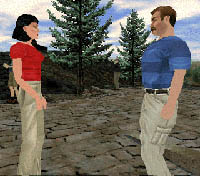I had a lot of trouble with the graphics, especially at the start. I could see the seams of the game world where polygons didn't quite meet, as if it was a Hanna-Barbera cartoon, and shadows flickered back and forth between being smoothly textured and blockily rendered. To top it off, I experienced graphics-related freezes which forced me to reboot from time to time. Altering the game's graphics options alleviated these problems, but only to a certain degree. Throughout the game I would have to reboot about once an hour. Was the problem with my aging graphics card? The new video drivers I downloaded? DirectX? Who knows, and more importantly, who cares? I was forced to save early and often in case the game locked up, distracting me from the game.
Clipping problems, the bane of 3D games, also made an appearance. People stuck hands through themselves, through items, through walls.
As I mentioned earlier, in what was a very nice touch, sounds were used to give clues. The soundscapes of rooms were done tolerably well. Voice acting, though, ranged from tolerable to erratically bad. The worst offender is Tim Curry as Gabriel Knight. His southern accent wanders all over the map, and his occasional lapse into British pronunciation made Gabriel sound like he was from Virginia rather than Louisiana. For a particularly egregious example of voice over-acting, have Gabriel talk about his notebook when you first start the game.
Part of the problem with the voice acting is due more to the dialog than the acting per se. The dialog is often howlingly bad, with little feel for how people truly speak. It's a real shame, too, because there are moments where the dialog takes flight. But for every such moment there are several involving poor attempts at humor or bad sexual innuendoes that will make you wince.
In fact, there are so many sexual innuendoes that they deserve separate mention. There have been elements of sexual tension and humor in the previous Gabriel Knight games, but GK3 reaches a new depth. "I've never had me an Asian girl before," one character tells Grace. At least he's supposed to be a boor; Gabriel's stream of single entendres are truly over-the-top. They are supposed to establish Gabe as a ladies' man with a keen wit. Instead, he comes across as that college buddy of yours who was always going to parties and making an ass of himself. You start to feel embarassed for Gabriel after a while.
The interface is interesting. Your point of view is not Gabriel's or Grace's. You move the camera around with the mouse, leaving Gabriel (or Grace) behind, and click on items to interact with them. If Gabriel isn't in the camera's field of view, he walks on-screen from directly off-screen, skipping all intervening space. It's a nice touch, one which alleviates the frustration of waiting for Gabriel to walk all the way to where you want him. It also makes moving around fairly fast, though I still wish I could have double-clicked on an exit and leave immediately. You could click on an exit and hit ESC to speed things up, but occasionally I would hit ESC twice and miss a cut-scene in the next room.
(There is one odd feature of the camera: You can move through people. Their outer layers peel away, letting you see right through them. I understand why the engine lets you do this, but it's an unsettling effect the first time you do it by accident.)
An example of the icon interface
(no enlarged shot)
When you right-click on an item, a list of icons pop up, indicating potential actions. The interface designers deserve kudos, because I could often tell what actions the icons represented without checking their pop-up descriptions. Sometimes actions were listed before you could perform them; early on you find trees which offer a "hide" icon, but you can't actually hide behind them until later. One action that you can sometimes perform is "think," which gives you hints as to what to do with that item. It's a nice touch.
I've got one random note about the interface that's not exactly about the interface: save and restore are fast. Having played a number of games in which restoring a saved game took minutes, it's nice to play one with restore times that take place in a handful of seconds. It's often faster to restore a game than to move to another room.
The major problem with the plot is how slowly it begins. The prologue contains a lot of action, but you only get to read about it. Instead, gameplay begins the next morning in Rennes-le-Château. You have no real tasks other than wandering around a mostly-empty city and meeting people. The game world is wide-open and you're given no direction. More sub-tasks, designed to gradually introduce the city and suspects, would have helped get players through the initial lack of direction.
Most of the puzzles in the game involve some form of detective work. You have to find where characters have gone and talk to them to find out what they're up to. There are more traditional adventure puzzles, in which you have to manipulate inventory items in unusual ways, but there aren't many of them in the early going. There aren't a lot of puzzles requiring careful timing, either. The main plot won't move on without you, and the sub-plots give you time to follow along if you're only paying attention. However, in the end-game there are several timed puzzles. They aren't bad ones, but they come as a surprise after being able to spend all the time you wish on each main puzzle.
The best puzzle, to my mind, is really a series of puzzles involving SIDNEY, a computer which appears to operate as much by magic as by technology. With SIDNEY you can send and receive e-mail, add data about suspects, make fake IDs, look up information in its online database, translate documents (!), and analyze pictures and text in various ways. The SIDNEY puzzle gives you the chance to be a researcher and detective. Solving it gave me the thrill of discovery. However, it's a complex and difficult puzzle, and at times is insufficiently clued. The game will give you hints if you so desire, and I recommend turning to them if you find yourself completely stumped. It's a great puzzle, but not worth missing the rest of the story for.
There are a number of game elements which aren't crucial but are irritating when taken together. There is no way to restart the game other than quitting and then reloading. There are items which you can't pick up until after a certain time, and no good reason for this is ever given. If you try to use items together, most of the time Gabriel will flatly tell you, "Those don't work together." This is especially annoying when you're trying to combine two items which could clearly be used together, like a drinking glass and a plaza water fountain.
None of these are show-stoppers, but they are what helps to keep GK3 from being an amazing game. The big things are there: a good plot and decent puzzles. But the little touches are missing, and some of the things I expected to be good, like the dialog and voice acting, aren't. Is the game worth playing? Yes, definitely. It was entertaining, and once I got past the rudderless beginning, the plot entranced me. But at times the game feels like a collection of slightly mis-matched parts, and that's what make it a solid effort instead of a transcendant one.
Recommended computer: Pentium 166 if you have at least a 1st-generation 3D accelerator card with 4MB of RAM; Pentium 233 if not. A Pentium II 266 is preferred, and they're not kidding -- this game's engine is a resource hog. 32MB of RAM is the minimum amount of memory needed, but I'd recommend at least 64MB.
My computer: Pentium Celeron 266 MHz (overclocked to 300 MHz), 192MB of RAM, Viper V330 4MB graphics card (a 1st-generation accelerator), Soundblaster 16 sound card.
1 | 2

